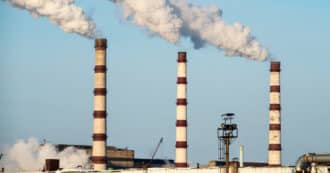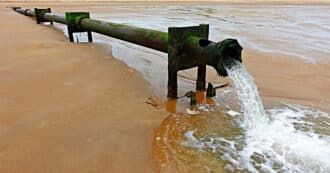What is soil pollution?
When we speak about soil pollution, we’re referring to human-generated pollution finding its way into the earth which negatively affects the ecosystems down to the microscopic levels. This soil contamination is usually in the form of soil contaminants like artificially produced chemicals, concentrated fossil fuel byproducts, nuclear or other forms of toxic waste that degrade our environment.
Not all waste pollutes the soil
While civilization has advanced considerably in science, it’s still a stretch scientifically to say that something man made is not ‘natural’- how would we define what is and isn’t? This demarcation is therefore fuzzy between normal ‘waste’ and actual ‘pollution’ in any given set of cycles. It’s more about how concentrated it is, and where it winds up compared to that soil’s ability to absorb it back into its natural uptake processes- and what role humans played in moving it around or dumping it somewhere. So waste such as banana peels or bat guano, ash from fires or even much human sewage need not become ‘pollution’. But some of the concentrated chemicals we have created are so far removed from their places of origin and place in the normal cycles that they are not easily re-absorbed into the soil, often causing great harm. These, we call contaminants or soil pollution.
What are soil contaminants?
In urban areas, soil contamination is largely caused by human activity. The type of soil will also play a role in its distribution. Certain contaminants may reach groundwater sources more easily in sand than in clay or loamy soils. Contaminants may also be retained at a site, which could pose on-site risk of exposure.
Main Cause of Soil Pollution – Humans
The leading causes of soil pollution are ultimately rooted in human indifference or deliberate damage. Consumers litter non-biodegradable objects like plastic bags which degrade into micro-plastics that have the ability to infiltrate everywhere. Landfills, dumps, and sewage outflows routinely cause soil pollution from most cities. Effluents and tailings from mining and quarrying activities which pit and scar the earth, turn it into ‘slurry’ of the mixed remains of the whole side of a hill. The targeted element of the mine is leached or removed from a large pile, and the slurry is usually dumped nearby. Many factories create varieties of concentrated wastes which cannot be easily disposed of or stored and therefore find their way into the soil. In addition, chemical fertilizers in agriculture and gardens seep into the soil and water supply.
Xenobiotics Cause Soil Contamination
So, therefore, what we call soil pollution or soil contamination is caused by the presence of “xenobiotics,” e.g. human-made chemicals or alteration in the natural soil environment. It is typically caused by industrial activity, agricultural chemicals or the improper disposal of waste. The most common chemicals involved are petroleum hydrocarbons, solvents, minerals, lead, and other heavy metals. Contamination is highly correlated with the degree of industrialization and the intensity of the chemical substance. Mapping the contaminated soil sites, and the resulting cleanups necessary are time-consuming and they are both expensive tasks requiring extensive amounts of investment in geology, hydrology, chemistry, computer modeling skills, and GIS in environmental contamination.
Environmental geology
A significant role of the environmental geology profession is devoted to determining levels of soil contaminants at a given site, remediation of the soil pollution, and certification of the land as ready for other uses, once it has been treated. In formerly industrial zones it is recommended or required to test the ground’s safety and its resulting implications for health before future use.
Rooted in Culture and Faith
Soil pollution is a consequence to the environment of many factors affecting land, soils, food, and health, but they are all rooted in cultures that don’t take full responsibility for the cycles of what they produce and expel or waste. In contrast, some more traditional cultures are more sustainable, such as the terraced rice paddies of a place like Bali. Built over centuries of relatively isolated dependence on inter-cooperation of all its residents, Bali’s famous landscape is shaped by intricate soil, water, irrigation, and waste management practices. Not out of a modern environmental consciousness but rather out of a combination of necessity and their Hindu faith, they neither produce things that cannot be re-absorbed into the growth cycles, nor get rid of their excess wastes, even human waste, which is processed into fertilizer along with fish bones and locally available minerals.
Consciously Protecting our Soil
In most of the modern west, we have neither the consciousness or spirituality guiding an integrated valuing of our landscape, nor the practices of reusing and reabsorbing all of our wastes into our productive relationship with our contaminated land. To prevent the continuation of soil degradation we have to recognise it and become conscious to its importance.
Agricultural Practices
Intensive agriculture runs the risk of exhausting the nutrients in the soils, except in cases of regular annual floods that deposit new topsoil, such as used to be the case in Egypt’s Nile River Valley. Fertility of the soil is often fragile, and thus since the beginnings of civilization, farmers have learned by trial and error the necessity of adding substances like animal manure, fish bones, or other materials to help fertilize and replenish the soil. The invention of artificial fertilizers using chemicals such as nitrates in the last 150 years seemed to initially greatly enhance food production, but this was at the cost of the longer term sustainability of the soil. So now, much of the soil that all our crops and other life forms on land depend on, is polluted with artificial pesticides, fertilizers, herbicides, slurry, debris, and plastics. The soil has been contaminated in many places.
Industrial Pesticides and Herbicides
Agriculture means modifying the ecosystem to encourage the plants and animals we prefer. This generates a sort of moral logic where any organisms that act in ways that eat, harm, or replace the species we have planted, become re-defined as ‘pests’ or ‘weeds’ or ‘vermin’. Since the start of the industrial revolution, artificial substances have been invented, distributed and used to limit, repel, or kill these undesired species.
What are pests?
Pests include insects, plant pathogens, weeds, mollusks, birds, mammals, fish, nematodes (roundworms) and microbes that compete with us for food, destroy property, spread widely, are a vector for disease or cause a nuisance. There are benefits to the use of pesticides, which are designed to efficiently protect our food crops and animals by targeting, repelling, or killing the pests or insects that are harming our crops (the root ‘cide’ means ‘kill’). But do the disadvantages of using pesticides outweigh these “benefits”?
Drawbacks
But there are also drawbacks to such pesticides, such as potential unintended toxicity to human health and other organisms beyond their intended targets, and sometimes other forms of downstream toxicity and impacts to the ecosystem. DDT was used on a massive scale from the 1930s, with a peak of 72,000 tonnes used in 1970. Instead of just killing the intended targets such as mosquitoes, DDT caused terrible toxic problems to the larger environment, such as damaging the eggshells and thus reproductive viability of several apex predator birds that were higher up the food chain from the DDT-saturated mosquitoes. Pesticides can accumulate at high or even toxic concentrations and cause similar damage to many, many species on which the health of the soil depends.
Conclusion: Human Health Depends on Soil Health
Many civilizations going back to Sumer have exhausted their soils and seen their civilization collapse as a consequence. We must aspire to a comprehensive change in our harmful practices to ensure the health of the soil on which our continuing existence and survival depend.
By Matthew Mausner
* Featured image source








